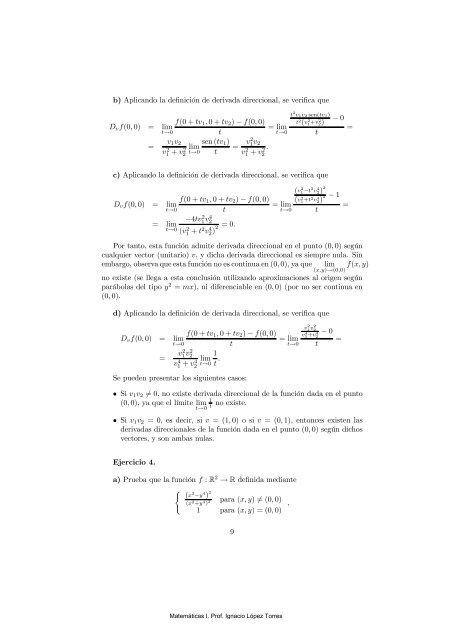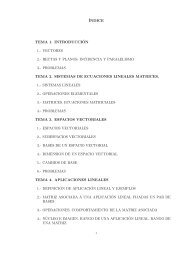ejercicios de cálculo diferencial en funciones de varias variables
ejercicios de cálculo diferencial en funciones de varias variables
ejercicios de cálculo diferencial en funciones de varias variables
You also want an ePaper? Increase the reach of your titles
YUMPU automatically turns print PDFs into web optimized ePapers that Google loves.
) Aplicando la <strong>de</strong>finición <strong>de</strong> <strong>de</strong>rivada direccional, se verifica que<br />
(0 + 1 0+2) − (0 0)<br />
(0 0) = lim<br />
→0<br />
<br />
=<br />
12<br />
2 1 + 2 2<br />
lim<br />
→0<br />
s<strong>en</strong> (1)<br />
<br />
= 2 12<br />
2 1 + 2 .<br />
2<br />
= lim<br />
→0<br />
2 12 s<strong>en</strong>(1)<br />
2 ( 2 1 +2 2)<br />
c) Aplicando la <strong>de</strong>finición <strong>de</strong> <strong>de</strong>rivada direccional, se verifica que<br />
(0 + 1 0+2) − (0 0)<br />
(0 0) = lim<br />
= lim<br />
→0<br />
<br />
→0<br />
= lim<br />
→0<br />
−4 2 1 4 2<br />
(2 1 + 24 =0.<br />
2 )2<br />
<br />
− 0<br />
( 2 1−2 4 2) 2<br />
(2 1 +24 2) 2 − 1<br />
Por tanto, esta función admite <strong>de</strong>rivada direccional <strong>en</strong> el punto (0 0) según<br />
cualquier vector (unitario) , y dicha <strong>de</strong>rivada direccional es siempre nula. Sin<br />
embargo, observa que esta función no es continua <strong>en</strong> (0 0),yaque lim ( )<br />
()→(00)<br />
no existe (se llega a esta conclusión utilizando aproximaciones al orig<strong>en</strong> según<br />
parábolas <strong>de</strong>l tipo 2 = ), ni difer<strong>en</strong>ciable <strong>en</strong> (0 0) (por no ser continua <strong>en</strong><br />
(0 0).<br />
d) Aplicando la <strong>de</strong>finición <strong>de</strong> <strong>de</strong>rivada direccional, se verifica que<br />
(0 + 1 0+2) − (0 0)<br />
(0 0) = lim<br />
→0<br />
<br />
=<br />
2 1 2 2<br />
4 1 + 4 2<br />
1<br />
lim<br />
→0 .<br />
Se pue<strong>de</strong>n pres<strong>en</strong>tar los sigui<strong>en</strong>tes casos:<br />
= lim<br />
→0<br />
<br />
2 12 2<br />
4 1 +4 − 0<br />
2 =<br />
<br />
• Si 12 6= 0, no existe <strong>de</strong>rivada direccional <strong>de</strong> la función dada <strong>en</strong> el punto<br />
1<br />
(0 0), ya que el límite lim<br />
→0 no existe.<br />
• Si 12 =0, es <strong>de</strong>cir, si =(10) osi =(01), <strong>en</strong>tonces exist<strong>en</strong> las<br />
<strong>de</strong>rivadas direccionales <strong>de</strong> la función dada <strong>en</strong> el punto (0 0) según dichos<br />
vectores, y son ambas nulas.<br />
Ejercicio 4.<br />
a) Prueba que la función : R 2 → R <strong>de</strong>finida mediante<br />
( 2 4 2<br />
( − )<br />
(2 +4 ) 2<br />
para ( ) 6= (00) 1 para ( ) =(00) Matemáticas I. Prof. Ignacio López Torres<br />
9<br />
,<br />
=<br />
=



